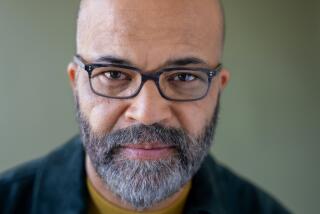The Wright Brothers as Preacher’s Kids : THE BISHOP’S BOYS A Life of Wilbur and Orville Wright <i> by Tom D. Crouch (W.W. Norton: $22.95; 585 pp., illustrated) </i>
- Share via
Not only did the Wright brothers invent the first flying machine, they simultaneously developed the art of flying, a kinesthetic spin-off from their experience as cyclists. In “The Bishop’s Boys,” Tom D. Crouch’s superb biography, he leads us through these accomplishments step by step, occasionally day by day, documenting their achievements with a formidable amount of data culled from the family archives in Dayton, Ohio, and from the Smithsonian Institution, where Crouch is chairman of Social and Cultural History at the National Museum of American History.
It draws us into a simpler America, where a pair of self-educated Midwestern bachelors successfully competed against better-funded, better-educated rivals at home and abroad to solve the tantalizing puzzle of aviation. Crouch puts to rest for good all claims that other inventors got there first. In the process, he describes the efforts and errors of these sometimes unscrupulous rivals.
Success at Kitty Hawk in 1903 did not bring the brothers instant fortune. They waited five years before they were able to patent their invention and protect their rights in Europe as well as in the United States because of the difference in patenting laws. While other fliers competed in contests and began to set new records, the Wrights stayed grounded. Finally, in 1908 they agreed to fly in Europe where they demonstrated at last that their claims were true. Some Europeans had accused the Wrights of greed. Crouch explains the Wright’s position. “The airplane was not their gift to the world, but a product for sale.”
As a product, it was ripe for theft. Crouch puts the Wrights’ battles over patent infringement into a new context by describing the idiosyncratic household in which the inventors grew up. Above them towered Bishop Milton Wright, an autocratic, didactic father who spent years in litigation with his own church and had his five children settle family disputes in mock trials. Orville and Wilbur grew up suspicious of the world beyond their family but prepared to combat the injustices they never doubted awaited them.
Though not formally educated beyond high school, neither inventor was a harebrained tinkerer. They were fastidious, cautious engineers. They had promised the Bishop that they would be careful and they were. During an early effort with a glider, they rigged up a tether for the pilot as a precautionary measure. Wilbur approached aeronautics logically, scanning the literature for answers to the fundamental problems: “What did one have to know to fly? What portions of the flying-machine problem were well in hand? What problems remained to be solved?” When they were ready to fly, Wilbur wrote to the U.S. Weather Bureau in Washington for a list of sites with high speeds. That is how they selected Kitty Hawk on the Outer Banks of North Carolina. The Kitty Hawk chapters are splendid. Crouch re-creates the morning of the first flight, when the brothers rose early, cut wood for a fire to heat water for shaving, and donned celluloid collars, white shirts and ties to haul their wooden machine to the launch rail.
This double biography--subtitled “A Life,” despite its two subjects--focuses on the dynamics between the brothers that enabled their talents to dovetail into genius. Aviation was not their first joint venture. They had already run a printing shop and a bicycle business. “Once Orville had committed himself to the flying machine experiments, there was a firm understanding between them that Wilbur’s initial leadership would be ignored,” Crouch writes. Accordingly, the brothers always took turns, both in the air and presenting their invention to potential buyers. They argued a lot, but remained united against what they saw as a hostile world. Crouch sums up their working relationship. “Wilbur had been interested in systems, in the big picture. Orville was the one who could make it work. He thought in terms of particular mechanisms, the bits and pieces that went together to form the big picture.” They worked brilliantly as a team.
Crouch tries to be fair, giving equal credit to each brother, but he clearly finds Wilbur more interesting. He falls occasionally from objectivity as when he shares their paranoia and writes: “Others waited, eager to take whatever unfair advantage they could.” This is the book that Wilbur and Orville would have wanted. The Bishop was an amateur genealogist and his sons clearly revered family, but Crouch’s introduction of early generations of Wrights at the start of the book serves no real biographical purpose save to placate their shades. Likewise, Crouch eschews psychological explanations, leaving the enormous body of evidence to speak for itself. But as the 20th Century draws to an end, is it enough simply to mention that Wilbur, like other 19th-Century figures, suffered a mysterious illness in late adolescence that kept him at home, unmarried, for the rest of his life, without attempting some interpretation?
Orville lived to carry the mantle of fame for both of them and to protect their historical legacy. A quiet man, he found celebrity distressing, disliked appearing in public, and refused all exhortations to speak. He once explained to a friend: “I know of only one bird, the parrot, that talks, and he can’t fly very high.” Orville, it seems, identified with the hawk.
More to Read
Sign up for The Wild
We’ll help you find the best places to hike, bike and run, as well as the perfect silent spots for meditation and yoga.
You may occasionally receive promotional content from the Los Angeles Times.






